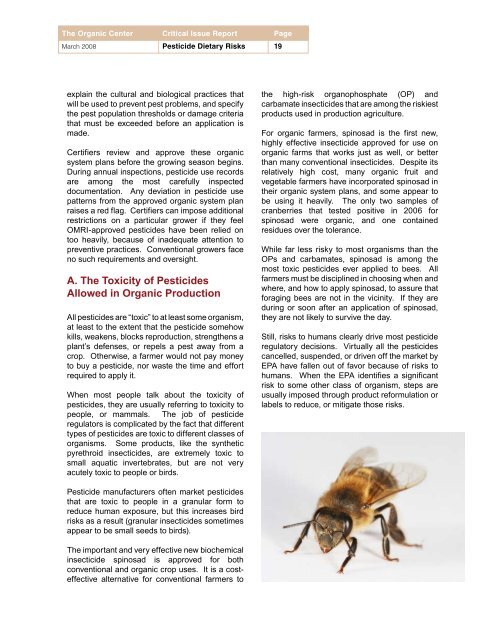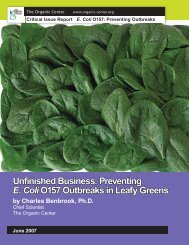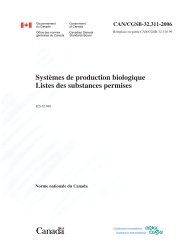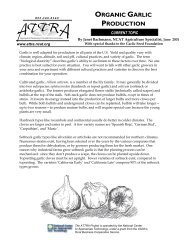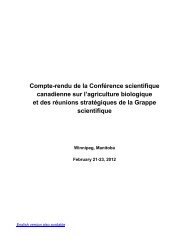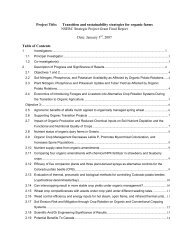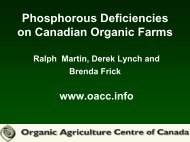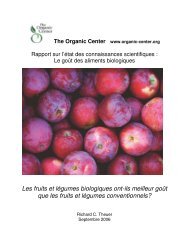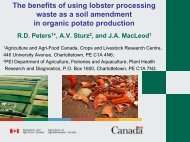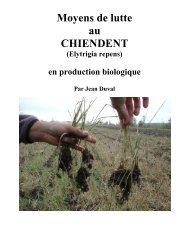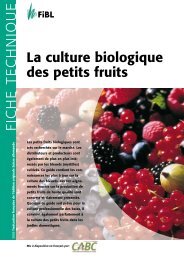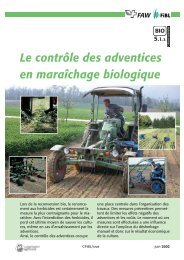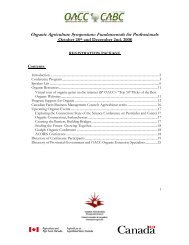The Organic Option - Centre d'agriculture biologique du Canada
The Organic Option - Centre d'agriculture biologique du Canada
The Organic Option - Centre d'agriculture biologique du Canada
Create successful ePaper yourself
Turn your PDF publications into a flip-book with our unique Google optimized e-Paper software.
<strong>The</strong> <strong>Organic</strong> Center Critical Issue Report Page<br />
March 2008 Pesticide Dietary Risks 19<br />
explain the cultural and biological practices that<br />
will be used to prevent pest problems, and specify<br />
the pest population thresholds or damage criteria<br />
that must be exceeded before an application is<br />
made.<br />
Certifiers review and approve these organic<br />
system plans before the growing season begins.<br />
During annual inspections, pesticide use records<br />
are among the most carefully inspected<br />
documentation. Any deviation in pesticide use<br />
patterns from the approved organic system plan<br />
raises a red flag. Certifiers can impose additional<br />
restrictions on a particular grower if they feel<br />
OMRI-approved pesticides have been relied on<br />
too heavily, because of inadequate attention to<br />
preventive practices. Conventional growers face<br />
no such requirements and oversight.<br />
A. <strong>The</strong> Toxicity of Pesticides<br />
Allowed in <strong>Organic</strong> Pro<strong>du</strong>ction<br />
All pesticides are “toxic” to at least some organism,<br />
at least to the extent that the pesticide somehow<br />
kills, weakens, blocks repro<strong>du</strong>ction, strengthens a<br />
plant’s defenses, or repels a pest away from a<br />
crop. Otherwise, a farmer would not pay money<br />
to buy a pesticide, nor waste the time and effort<br />
required to apply it.<br />
When most people talk about the toxicity of<br />
pesticides, they are usually referring to toxicity to<br />
people, or mammals. <strong>The</strong> job of pesticide<br />
regulators is complicated by the fact that different<br />
types of pesticides are toxic to different classes of<br />
organisms. Some pro<strong>du</strong>cts, like the synthetic<br />
pyrethroid insecticides, are extremely toxic to<br />
small aquatic invertebrates, but are not very<br />
acutely toxic to people or birds.<br />
the high-risk organophosphate (OP) and<br />
carbamate insecticides that are among the riskiest<br />
pro<strong>du</strong>cts used in pro<strong>du</strong>ction agriculture.<br />
For organic farmers, spinosad is the first new,<br />
highly effective insecticide approved for use on<br />
organic farms that works just as well, or better<br />
than many conventional insecticides. Despite its<br />
relatively high cost, many organic fruit and<br />
vegetable farmers have incorporated spinosad in<br />
their organic system plans, and some appear to<br />
be using it heavily. <strong>The</strong> only two samples of<br />
cranberries that tested positive in 2006 for<br />
spinosad were organic, and one contained<br />
resi<strong>du</strong>es over the tolerance.<br />
While far less risky to most organisms than the<br />
OPs and carbamates, spinosad is among the<br />
most toxic pesticides ever applied to bees. All<br />
farmers must be disciplined in choosing when and<br />
where, and how to apply spinosad, to assure that<br />
foraging bees are not in the vicinity. If they are<br />
<strong>du</strong>ring or soon after an application of spinosad,<br />
they are not likely to survive the day.<br />
Still, risks to humans clearly drive most pesticide<br />
regulatory decisions. Virtually all the pesticides<br />
cancelled, suspended, or driven off the market by<br />
EPA have fallen out of favor because of risks to<br />
humans. When the EPA identifies a significant<br />
risk to some other class of organism, steps are<br />
usually imposed through pro<strong>du</strong>ct reformulation or<br />
labels to re<strong>du</strong>ce, or mitigate those risks.<br />
Pesticide manufacturers often market pesticides<br />
that are toxic to people in a granular form to<br />
re<strong>du</strong>ce human exposure, but this increases bird<br />
risks as a result (granular insecticides sometimes<br />
appear to be small seeds to birds).<br />
<strong>The</strong> important and very effective new biochemical<br />
insecticide spinosad is approved for both<br />
conventional and organic crop uses. It is a costeffective<br />
alternative for conventional farmers to


